
By Olivia Rondeau, Gail Brant-Terry, Dianne Sedore-McCoy, and Patricia Sutherland
Introduction
We begin our article by recognizing our responsibility to the natural world. We acknowledge our duty to live in balance and harmony with each other and all living things. We bring our minds together and we offer greetings, thanks, and gratitude to the people, our Mother the Earth, the waters, the fish, the plants, the foods that sustain us, the medicines, the animals, the trees, the birds, the four winds, the thunderers, our eldest Brother the Sun, our Grandmother the Moon, the stars, and the Creator. If we have left anything out, we welcome everyone to send greetings and thanks in their own way.
This way of opening is known as the Ohèn:ton Karihwatéhkwen (Opening Address) by the Rotinonhsyón:ni (Mohawk, People of the Longhouse). There are many written and oral versions, all reflecting the same purpose. We share this shortened version from a place of care and in recognition of what our work is rooted in.
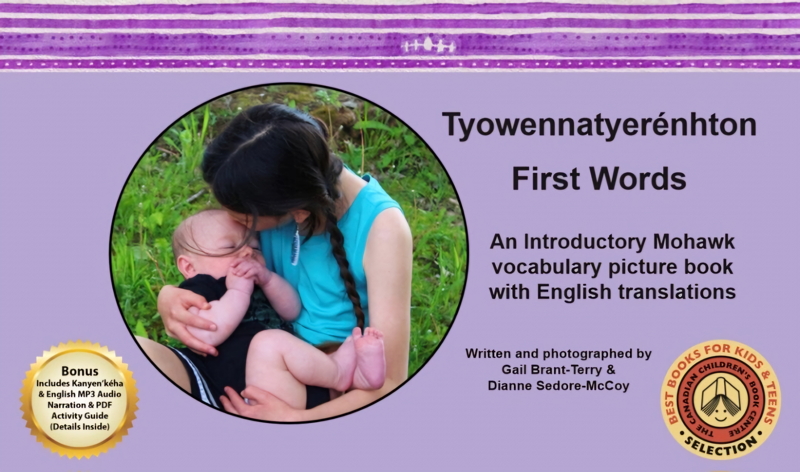
In this article, we will share with you the work of educators and a teacher librarian who have encompassed our knowledge, teaching, and learning around the picture book, Tyowennatyerénhton First Words written by authors Gail Brant-Terry and Dianne Sedore-McCoy. This book is the heart-work of two friends who grew up in the small town of Point Anne, Ontario on the Bay of Quinte looking for a way to share their heritage language, Kanyen’kéha with the future generations.
Indigenous Language Revitalization
The picture book, Tyowennatyerénhton First Words, selected by the Canadian Children’s Book Centre as a 2024 Best Book for Kids and Teens, focuses on the revitalization of Kanyen’kéha (Mohawk language) and shares vocabulary that celebrates the land, language, and culture of the Rotinonhsyón:ni. As we are currently living in the Decade of Indigenous Languages, this book is especially important in demonstrating language revitalization efforts being made by Indigenous families to pass their heritage languages on to the future generations and to ensure that those who come after us understand the importance of committing to language learning and honouring our responsibilities to our cultures and the land.
In the article, Indigenous Languages written by Bill LeBlanc (2023) he explains that conservative estimates suggest that more than half of the world’s languages will become extinct by 2100. However, without language revitalization efforts, there is a risk that a percentage of the world’s language could become extinct or nearing endangerment by the end of this century. LeBlanc (2023) encourages readers to engage with the United Nations Declaration on the Rights of Indigenous Peoples which shares in Article 13 that Indigenous peoples have the right to revitalize, use, develop, and transmit to future generations their languages, oral traditions, writing systems, and literatures. This Article is of importance to the work we are doing as it helps educators to understand not only the criticality of Indigenous language revitalization but that learning, sharing, and speaking Indigenous languages is rooted in rights-based and sovereign education practices.
“I don’t ever want to be the last speaker of the Mohawk language.”
Skahendowaneh Swamp (2016)
For this and so many other reasons, Indigenous authors, including Dianne and Gail have stopped publishing in English and French and have moved towards publishing in English and their Indigenous languages, helping Indigenous children see themselves represented in their stories across Turtle Island (North America).
For our Ancestors, For our Children
As we’ve shared, Tyowennatyerénhton First Words was written with love, our ancestors, the children, our future, in mind. Through this book, Gail is honouring the birth of her first grandchild. When her grandchild was entering the world, she wanted to present him with gifts that honoured both of his heritages. In looking for books that shared Rotinonhsyón:ni culture and language, she found that there were very few and that there was no First Words book for Kanyen’kéha. Unable to find a book, she decided to write one herself alongside Dianne who is honouring the gifts shared by her Kanyen’kéha teachers through their collective contributions of story, language, and photography to this book. Gail and Dianne are committed to supporting Indigenous language revitalization efforts and honouring their responsibilities to be stewards of the land. The majority of the pictures featured in the book were taken by Gail and Dianne on the traditional territory of the Haudenosaunee.
“Yethirihónnyon nithotiyèn:sas ne káti ratirihonnyén:ni ahón:ton’ – Let’s teach the young ones so that they may become teachers.”
Rohahiyo Brant (2022)
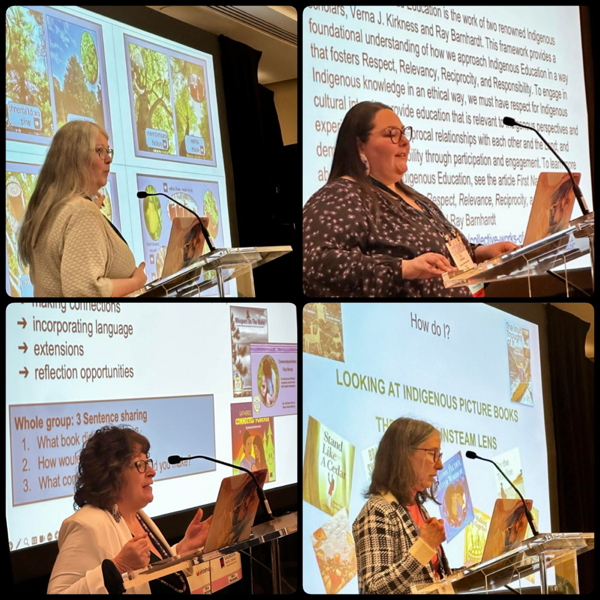
Association Super Conference 2024.
Dianne has spent many years taking classes and participating in efforts to learn Kanyen’kéha (Mohawk language). She is a graduate of the Mohawk Language and Culture Certificate offered by Queen’s University and Tsi Tyónnheht Onkwawén:na as well as a participant in the 2019 language class hosted at Kana’tsioharé:ke. In learning the language and sitting with language teachers, including Skahendowaneh Swamp, Thanyehténhas (Nathan Brinklow), Rohahiyo (Jordan Brant) and many others she understood the importance that this book has for the future generations and in contributing to the work of so many of our ancestors who have pathed the way for us to be able to share this work with people across Turtle Island (North America) and who have worked endlessly to preserve Kanyen’kéha so that we may all learn.
In understanding their responsibility to the preservation of their language and culture, Dianne and Gail made the decision for all net proceeds from Tyowennatyerénhton First Words to be donated to Tsi Tyónnheht Onkwawén:na to be put towards the new language and culture centre being built in Tyendinaga Mohawk Territory.
Land as First Teacher, Bringing Indigenous Pedagogies into Practice
Land and language have a symbiotic relationship, both uplifting the other. As Indigenous peoples, we have always rooted our learning in the land, and we believe it is important that the land continue to be centered in the work being done in classrooms, libraries, and other spaces. In our own work, we’ve brought the understanding of land as first teacher into the realm of STEAM (Science, Technology, Engineering, Art, and Mathematics) and the recognition of Indigenous presence in STEAM since time immemorial. In recent years, this way of knowing has begun to be referred to as INSTEAM.
An important aspect of INSTEAM is understanding the land as first teacher. Indigenous peoples have been learning from the land and bringing their teachings and observations into their languages, cultures, ceremonies, and practices. By doing this, we are centering the land in our learning and ensuring that relationships of reciprocity are established and continued with the land, throughout the year. This understanding of relationship is a significant part of the 4 Rs of Indigenous Education, the work of two renowned Indigenous scholars, Verna J. Kirkness and Ray Barnhardt (2001).
This framework provides a foundational understanding of how individuals in their work can approach Indigenous education in a way that fosters respect, relevancy, reciprocity, and responsibility. To engage in Indigenous knowledges in ethical ways, we must have respect for cultures, provide education that is relevant to Indigenous perspectives and experiences, foster reciprocal relationships with each other and the land, and show responsibility through participation and engagement. We share next the foundational ways that Tyowennatyerénhton First Words has been used in classrooms by educators who have fostered the importance of bringing Indigenous pedagogies into their teaching practice, in a way that celebrates, honours, and nourishes the learning spirits of Indigenous children and youth.
Using Indigenous Picture Books in the Classroom and Library
Tyowennatyerénhton First Words has been used in classrooms and libraries across Ontario, the photographs focusing on elements of the natural world providing an entry point to explore Indigenous technologies and practices (INSTEAM). There are many rich learning opportunities that educators have explored using the book and the accompanying Educator Guide written in collaboration with Olivia Rondeau and Patricia Sutherland. Some of the activities include an exploration of the text, inquiry-based learning, understanding colours and textures related to the natural world, the creation of eco art, and land-based learning opportunities. One of the many wonders of Tyowennatyerénhton First Words is that it is a text that can be re-visited throughout the entire year to learn and explore more things related to land, culture, language, and Indigenous approaches to STEAM.

Colours and textures related to the natural world.
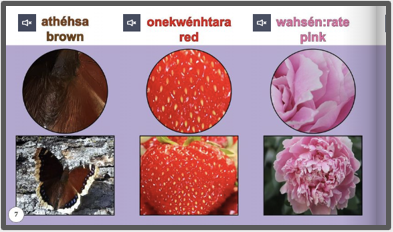
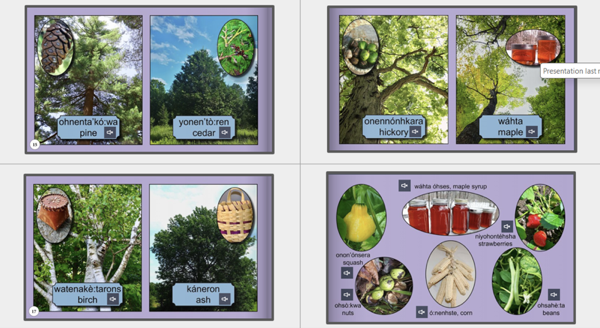
These culturally sustainable strategies can also be applied to most Indigenous authored and/or illustrated picture books. Look for the representations of land and natural elements in both text and illustrations through the lens of language as culture and practices gained from knowledge of the land (land as first teacher). For example, research the medicinal properties of plants and trees, study the math, physics and chemistry of built technologies from natural elements, explore the interconnectedness and sustainability of ecosystems, and marvel at the deep understanding of the stars and moons (astronomy). Let your curiosity and wonder provide the pathway for further inquiry!
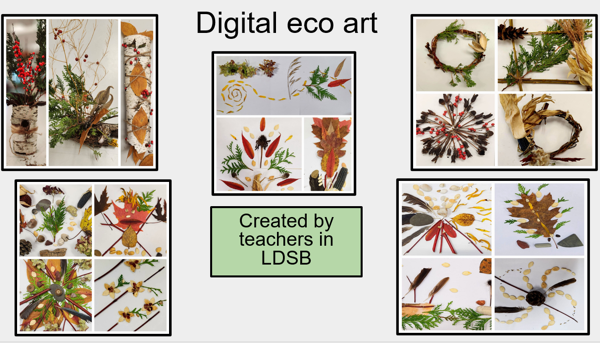
We encourage readers to foster their love for creativity and learning by considering ways that they can use this text, and other picture books, in multiple fields to contribute to the revitalization of Kanyen’kéha, Indigenous languages, and to help Indigenous peoples see themselves represented in spaces across Turtle Island.
Education for the Next Seven Generations
Many Indigenous peoples carry the teaching that the decisions we make today should result in a better and more sustainable world for the next seven generations. Through the creation of Tyowennatyerénhton First Words, the accompanying Education Guide, and the love that continues to be poured into the work of Gail and Dianne, it is our hope that you will carry this teaching with you as you continue in your respective fields and that you will consider the ways in which you can contribute to language revitalization, supporting Indigenous communities, and ensuring that our future generations can experience the feeling of home through language, land, and culture.
Tyowennatyerénhton First Words and accompanying educator guides can be purchased by contacting Gail Brant-Terry at gail.brantterry1[at]gmail.com. Tyowennatyerénhton First Words can also be purchased at Goodminds.
References
LeBlanc, Bill. (2023, March 31). Indigenous Languages Day. CFWE FM. https://cfweradio.ca/2023/03/31/indigenous-languages-day/#:~:text=Key%20facts%20about%20Indigenous%20languages%20in%20Canada%3A&text=Conservative%20estimates%20suggest%20that%20more,the%20end%20of%20this%20century
Mohawks of the Bay of Quinte. (n.d.). Ohèn:Ton Karihwatéhkwen. Mohawks of the Bay of Quinte. https://mbq-tmt.org/ohenton-karihwatehkwen/
Kirkness, V. J. and R. Barnhardt (2001). First Nations and Higher Education: The Four R’s – Respect, Relevance, Reciprocity, Responsibility. In Knowledge Across Cultures: A Contribution to Dialogue Among Civilizations. R. Hayoe and J. Pan. Hong Kong, eds., Comparative Education Research Centre, The University of Hong Kong. https://www.uaf.edu/ankn/publications/collective-works-of-ray-b/Four-Rs-2nd-Ed.pdf
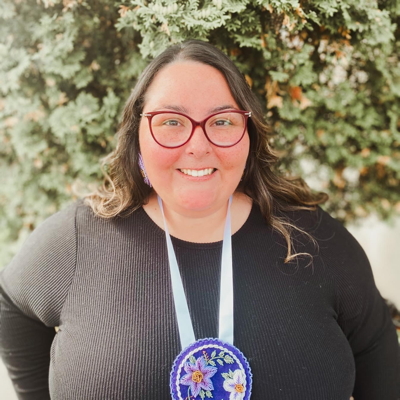
Liv Rondeau, Akwesasne Mohawk Territory, is an educator, artist, and language activist. She holds the position of Vice-Principal of Indigenous Education and Reconciliation Lead at the Limestone District School Board. She is a graduate of Queen’s University’s Master of Education program, where her research focused on language revitalization. Liv is a recipient of the Agnes Benedickson Tricolour Award (2019) for her commitment to Indigenous education and activism.

Gail Brant-Terry, Mohawks of the Bay of Quinte, has over 33 years of experience in education as a teacher and administrator at the school, system, and provincial level. Co-Founder and Principal Consultant of Ridge Road Training & Consulting, Gail was Indspire’s 2020 Guiding the Journey award recipient for Leadership in Indigenous Education.

Dianne Sedore-McCoy is an educator, with over 25 years experience as a classroom teacher, Curriculum Coordinator in Indigenous education, and a cultural advisor at the board level. She graduated from Queen’s University Mohawk Language and Cultural program in 2020, and is certified in Specialized Expressive Arts Therapy through CiiAT (Canadian International Institute of Art Therapy). Dianne is an Honourary Lifetime Member of the Elementary Teachers Federation of Ontario.
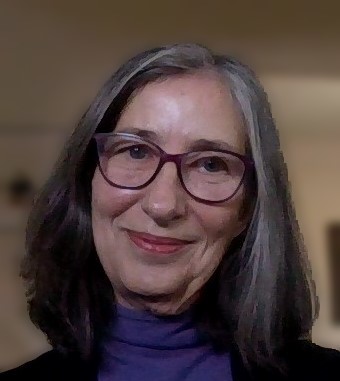
Patricia Sutherland has worked for over 30 years with children, families, students and educators to bring the joy of diverse books into the home and classroom. Patricia holds a Master of Library and Information Science from the University of Western Ontario and a Master of Education from the University of Illinois at Urbana-Champaign.